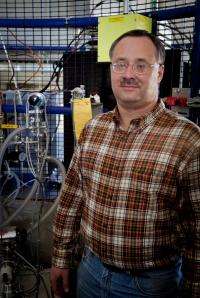Lithium chloride enables neutron studies of protein-solvent interactions at supercold temperatures

Researchers at the Spallation Neutron Source BASIS beam line at the Department of Energy's Oak Ridge National Laboratory have successfully developed a method to study biomolecules (proteins) at temperatures far below freezing using a lithium chloride preparation in the aqueous solvent that prevents freezing.
Studying biosamples at supercold temperatures - 200 Kelvin - was previously impossible, as the water in such a solution inevitably freezes, and with it, the biosample's dynamic interactions freeze, too. The ability to study proteins at these temperatures gives researchers an important new avenue for understanding how they function in living organisms.
Neutron researchers need to study the dynamic interaction of proteins and their aqueous solvent at very low temperatures to understand their vibrational behavior at the atomic level. Then, while slowly raising the temperature to physiological conditions, they can study the unique biological "relaxational" motions that dominate as the temperature is raised.
Quasi-elastic neutron scattering (QENS) can then literally snap pictures as the dynamic interactions of the sample and water gradually "switch on" with the rise in temperature. How to keep the biosample from freezing at very low temperatures has been an ongoing research problem.
Now Eugene Mamontov, lead instrument scientist at the SNS's Backscattering Spectrometer (BASIS) and Xiang-qiang Chu, his postdoc of two years, have successfully navigated this research roadblock with a unique method that stops the hydrated biomolecule from freezing.
In a series of papers over several years, Mamontov and Chu had already shown that a lithium chloride aqueous solution is remarkably similar in its dynamics to pure water. And more significantly, they found that at very low temperatures, it does not freeze.
With the assistance of Hugh O'Neill and Qiu Zhang of the Biology and Soft Matter Division in ORNL's Neutron Sciences Directorate, who prepared the samples and performed the samples characterization, they mixed an aqueous solution of lithium chloride with protein, producing a slurry with bulk-like water inside.
"You look at it and you can't tell the difference between the solution and pure water," Mamontov explained. "You measure the dynamics. There is very little difference. Yet, unlike water, the stuff does not freeze down to about 200 Kelvin. It changes to a thick, glassy consistency; however it remains water-like." The lithium chloride aqueous solution "resembles more what is inside us, what is in living things," Mamontov said. "The protein kind of floats, moving inside the solvent (which is mostly water) - a much more realistic portrayal of proteins in living cells."
In a recent paper, they successfully studied the dynamics of the protein at many different temperatures in a realistic aqueous environment, without freezing. Proteins at temperatures as low as liquid helium or nitrogen behave essentially like atoms in any regular solid. They vibrate as every atom and molecule vibrates in any solid.
But, when warmed, in addition to vibrating, Mamontov explained, "they start to do something else. They start to make relaxational motions. Think of tentacles, or some kind of mop with which you sweep the floor.
"We have known for a long time that the dynamics of the solvent and the dynamics of the biomolecule are somehow coupled," Mamontov said. The question is whether one is dependent on the other, whether they are "enslaved" or just influence one another somehow.
Mamontov says the BASIS instrument is uniquely suited to study the problem. Unlike other spectrometers, BASIS can separately and simultaneously measure both the activity of the solvated protein and the aqueous solution that surrounds it.
The description of the new method of studying biomolecules at very low temperatures, the early experimental results, and the experiments that can ensue with the resolution of this long standing problem appear in a special Perspective review paper in the Royal Society of Chemistry's Physical Chemistry Chemical Physics.
"It is important to an understanding of life," Mamontov said. "It is fundamentally important to biological science. We need to know how the protein conforms, how it responds to the changing temperature of its solvent, in order to understand how a protein functions inside us."
The neutron scattering experiments at Oak Ridge National Laboratory's (ORNL) Spallation Neutron Source were sponsored by the Scientific User Facilities Division, Office of Basic Energy Sciences, U.S. Department of Energy.
More information: Eugene Mamontov and Xiang-qiang Chu, Water-protein dynamic coupling and new opportunities for probing it at low to physiological temperatures in aqueous solutions. Phys. Chem. Chem. Phys., 2012, 14, 11573-11588. DOI: 10.1039/c2cp41443k
Provided by Oak Ridge National Laboratory



















